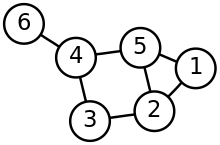
Back جوار (نظرية البيان) Arabic Veïnat (teoria de grafs) Catalan Nachbarschaft (Graphentheorie) German Vecindad (teoría de grafos) Spanish مجاور (نظریه گراف) Persian Voisinage (théorie des graphes) French Susjednost (teorija grafova) Croatian Szomszédság (gráfelmélet) Hungarian Vizinhança (teoria dos grafos) Portuguese Окрестность (теория графов) Russian

In graph theory, an adjacent vertex of a vertex v in a graph is a vertex that is connected to v by an edge. The neighbourhood of a vertex v in a graph G is the subgraph of G induced by all vertices adjacent to v, i.e., the graph composed of the vertices adjacent to v and all edges connecting vertices adjacent to v.
The neighbourhood is often denoted or (when the graph is unambiguous) . The same neighbourhood notation may also be used to refer to sets of adjacent vertices rather than the corresponding induced subgraphs. The neighbourhood described above does not include v itself, and is more specifically the open neighbourhood of v; it is also possible to define a neighbourhood in which v itself is included, called the closed neighbourhood and denoted by . When stated without any qualification, a neighbourhood is assumed to be open.
Neighbourhoods may be used to represent graphs in computer algorithms, via the adjacency list and adjacency matrix representations. Neighbourhoods are also used in the clustering coefficient of a graph, which is a measure of the average density of its neighbourhoods. In addition, many important classes of graphs may be defined by properties of their neighbourhoods, or by symmetries that relate neighbourhoods to each other.
An isolated vertex has no adjacent vertices. The degree of a vertex is equal to the number of adjacent vertices. A special case is a loop that connects a vertex to itself; if such an edge exists, the vertex belongs to its own neighbourhood.


![{\displaystyle N_{G}[v]}](https://wikimedia.org/api/rest_v1/media/math/render/svg/70d0730ce5bb03368f6dda06206b1e59278c8bf4)